|
|
|
Published
on 13
Apr 2006
|
All rights reserved.
|
|
|
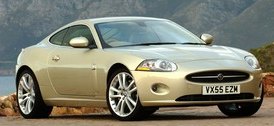 From
E-Type, XJS to XK8, there was one common gene in their blood:
smoothness. No matter powered by straight-6, V12 or V8, these cars
never forgot to place smoothness at top priority – smooth engines,
smooth ride and smooth styling. They were the best luxurious grand
tourers of their time, not as sporting as German rivals but more
civilized and arguably more tasteful. From
E-Type, XJS to XK8, there was one common gene in their blood:
smoothness. No matter powered by straight-6, V12 or V8, these cars
never forgot to place smoothness at top priority – smooth engines,
smooth ride and smooth styling. They were the best luxurious grand
tourers of their time, not as sporting as German rivals but more
civilized and arguably more tasteful.
The latest XK wants to succeed this tradition. However, there are
plenty of changes made. First of all, its name has lost the letter “8”,
although it keeps the same 8-cylinder engine as its predecessor.
Secondly, its chassis and body have been changed to all-aluminum
construction, just like the XJ sedan. Thirdly, its suspension setup has
injected a fair degree of sportiness (to distinguish itself from Lexus
SC ?) but without going to the German level. Lastly but not least, its
styling signals a change of philosophy and the start of a new era to
Jaguar.
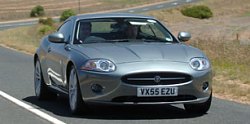 We
start from the styling. XK is the first Jaguar designed completely
under the direction of Ian Callum. In other words, it finally leaves
the classical approach of the great late Geoff Lawson (see XK8, S-Type,
X-Type and most of the current XJ). You might remember Callum is famous
for designing Aston Martin DB7 and Vanquish, but since then he has not
had any masterpieces added under his name. Obviously, the hungry Callum
wants to set a new design direction for the next generation Jaguars,
but his first attempt seems haven’t won too many praises. Most people
found the new XK not as attractive as Henrik Fisker’s Aston Martin DB9
and V8 Vantage. Its lines are less sexy, its headlights are quite oddly
shaped and, horribly, its oval front intake seems coming from the
recycle bin of Ford (see the old Ford Taurus and Mondeo), although we
know Jaguar actually adopted that feature as early as the E-type. We
start from the styling. XK is the first Jaguar designed completely
under the direction of Ian Callum. In other words, it finally leaves
the classical approach of the great late Geoff Lawson (see XK8, S-Type,
X-Type and most of the current XJ). You might remember Callum is famous
for designing Aston Martin DB7 and Vanquish, but since then he has not
had any masterpieces added under his name. Obviously, the hungry Callum
wants to set a new design direction for the next generation Jaguars,
but his first attempt seems haven’t won too many praises. Most people
found the new XK not as attractive as Henrik Fisker’s Aston Martin DB9
and V8 Vantage. Its lines are less sexy, its headlights are quite oddly
shaped and, horribly, its oval front intake seems coming from the
recycle bin of Ford (see the old Ford Taurus and Mondeo), although we
know Jaguar actually adopted that feature as early as the E-type.
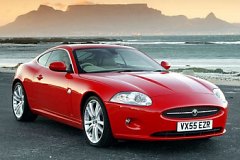 However,
we must appreciate his insistence of a low bonnet line, which was a
traditional feature of Jaguar. To comply with European pedestrian
safety law – which requires a substantial clearance between the bonnet
and the engine – most other car makers chose to employ higher bonnets,
which usually ruin the sleek lines of sports cars. Instead, Jaguar’s
engineers work together with Volvo’s safety experts to develop the
world’s first pop-up bonnet. During a collision, the bonnet pops up and
therefore creates a large clearance from the engine. It saves the
pedestrian and saves the style simultaneously. However,
we must appreciate his insistence of a low bonnet line, which was a
traditional feature of Jaguar. To comply with European pedestrian
safety law – which requires a substantial clearance between the bonnet
and the engine – most other car makers chose to employ higher bonnets,
which usually ruin the sleek lines of sports cars. Instead, Jaguar’s
engineers work together with Volvo’s safety experts to develop the
world’s first pop-up bonnet. During a collision, the bonnet pops up and
therefore creates a large clearance from the engine. It saves the
pedestrian and saves the style simultaneously.
The interior design is less successful. Ian Callum has never been good
at cabin design, and his weakness is shown in the new XK. Here is a
rather bland and characterless place. It lacks the classical theme of
traditional Jaguars and the elegant feel of Aston Martins. Instead, it
looks more like a Japanese or an American offering.
 However,
it is undeniable that the new XK is much better made than its
predecessor. The material is of high quality to shame 911 owners and
the fit and finish matches its price tag. It is also more comfortable
and practical than before. The driver will find more headroom and
legroom, thanks to a taller roof and extended wheelbase. Yes, the rear
seats are still dog seats, but this is not much a problem to its
customers – they typically own a Rover Range and a Mercedes S-class
beside the Jaguar GT. For two people, XK will be a fine place for any
journeys. However,
it is undeniable that the new XK is much better made than its
predecessor. The material is of high quality to shame 911 owners and
the fit and finish matches its price tag. It is also more comfortable
and practical than before. The driver will find more headroom and
legroom, thanks to a taller roof and extended wheelbase. Yes, the rear
seats are still dog seats, but this is not much a problem to its
customers – they typically own a Rover Range and a Mercedes S-class
beside the Jaguar GT. For two people, XK will be a fine place for any
journeys.
The chassis and body of XK is made of aluminum like XJ sedan. In other
words, most parts are made of extruded and cast aluminum. They are
bonded by rivets, adhesives and self-piercing screws. Although most
toolings share with XJ, it still costs thousands of pounds more than
conventional steel monocoques. However, from engineering point of view
the switch to aluminum construction is worthwhile - compare with the
old car, kerb weight has been down by nearly 100 kilograms to 1595kg,
undercutting BMW 650Ci (1640kg) and Mercedes SL500 (1770kg). At the
same time, torsional rigidity has been lifted by 31% to 30,000
Nm/degree. That’s even stiffer than Aston V8 Vantage and Ferrari F430 !
 The
lightweight is very crucial, because the new XK continues to rely on
the long-serving 4.2-litre V8 from its predecessor. This AJ-V8 has been
around us since 1996 when XK8 was born. Despite of its age, its
specification is still up to date: all-aluminum construction, Nikasil
coating on combustion chambers to reduce friction, quad-cam 32 valves,
variable valve timing on the intake side and drive-by-wire throttle.
This shows how advanced it was 10 years ago. Although its maximum power
and torque remains at 300 hp and 310 lbft, with 100 less kilograms to
pull it can shorten 0-60 mph to 5.9 seconds, while top speed remains
regulated at 155 mph. The
lightweight is very crucial, because the new XK continues to rely on
the long-serving 4.2-litre V8 from its predecessor. This AJ-V8 has been
around us since 1996 when XK8 was born. Despite of its age, its
specification is still up to date: all-aluminum construction, Nikasil
coating on combustion chambers to reduce friction, quad-cam 32 valves,
variable valve timing on the intake side and drive-by-wire throttle.
This shows how advanced it was 10 years ago. Although its maximum power
and torque remains at 300 hp and 310 lbft, with 100 less kilograms to
pull it can shorten 0-60 mph to 5.9 seconds, while top speed remains
regulated at 155 mph.
Nevertheless, the 4.2-litre V8 can no longer matches its new rivals for
power and torque. For example, Maserati 4200GT produces 400hp and 332
lbft, BMW 650Ci kicks out 367hp and 361 lbft while Mercedes SL500 pumps
out 388hp and 391 lbft. They not only deliver stronger acceleration
than the Jaguar, but their superior low end grunt is obvious in regular
driving.
So what? The beauty of XK has never been hot-rod performance, but a
refined and relaxed manner. Unlike the aforementioned rivals, it is a
true luxurious grand tourer – the one that will cover ground quickly
yet comfortably. Undoubtedly, the new XK has a very good drivetrain
combo to fulfill this task. Its AJ-V8 is still very smooth and refined;
its ZF 6-speed automatic transmission is also a source of joy. In
automatic mode it shifts seamlessly. In the paddle-shift manual mode (a
new feature of the car) it responds so quickly and matches the rev so
well.
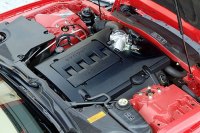 The XK
also rides and handles very well. The starting point is a rigid yet
lightweight chassis. Base on that are suspensions derived from the XJ
sedan. They got rid of air springs but retained the CATS adaptive
damping. The tuning is sportier than the old XK8 but not to the extent
of BMW 650Ci. The XK
also rides and handles very well. The starting point is a rigid yet
lightweight chassis. Base on that are suspensions derived from the XJ
sedan. They got rid of air springs but retained the CATS adaptive
damping. The tuning is sportier than the old XK8 but not to the extent
of BMW 650Ci.
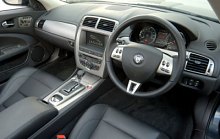 At first,
you will feel it rides harder than the old car, but as speed rise the
damping gets increasingly beautiful. Obviously, the suspensions are
much more absorbent than the German and Italian rivals, and the driver
feels much more relaxed when cruising in the XK. At first,
you will feel it rides harder than the old car, but as speed rise the
damping gets increasingly beautiful. Obviously, the suspensions are
much more absorbent than the German and Italian rivals, and the driver
feels much more relaxed when cruising in the XK.
At the same time, the new XK displays a vast improvement in handling.
Its steering manner is agile, willing and neutral. Its tires generate
tremendous grip. Although it rolls more than 650Ci and the ABC-equipped
Mercedes SL, it is not a shame for a luxurious grand tourer, and is a
big improvement from the bulky XK8. The only real problem is a steering
that delivers no much feel from the road. However, neither BMW nor
Mercedes are truly feelsome.
This mean the XK is a good luxurious GT. It has refined engine and
drivetrain, superb ride, capable handling and fine build quality to
deliver what its customers demand. What it lacks is desirability. Quite
unbelievably, the missing link comes from Ian Callum’s exterior and
interior design. |
Verdict:     |
Published
on 13
Apr 2006
|
All rights reserved.
|
|
XK Convertible
|
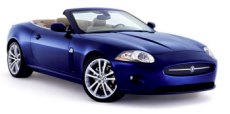 The
convertible version is very important to the sales of XK, as
traditionally this kind of version contributes to half of the sales of
the segment. However, the conversion from coupe to convertible is not
as brilliant as Porsche and Ferrari did to their cars. Although Jaguar
claims the chassis of XK Convertible is 60% stiffer than its
predecessor, at 16000 Nm / degree it is only half the value of the XK
Coupe. As a result, it lost some finesse in ride and handling when
being pushed hard. Moreover, the Convertible’s windscreen design does
not contain wind buffeting very well. In short, the Coupe is the XK we
want. The
convertible version is very important to the sales of XK, as
traditionally this kind of version contributes to half of the sales of
the segment. However, the conversion from coupe to convertible is not
as brilliant as Porsche and Ferrari did to their cars. Although Jaguar
claims the chassis of XK Convertible is 60% stiffer than its
predecessor, at 16000 Nm / degree it is only half the value of the XK
Coupe. As a result, it lost some finesse in ride and handling when
being pushed hard. Moreover, the Convertible’s windscreen design does
not contain wind buffeting very well. In short, the Coupe is the XK we
want. |
Verdict:    |
Published
on 16
Sep 2006
|
All rights reserved.
|
|
XKR
|
|
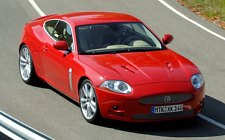 If
the naturally aspirated XK is good, then the supercharged XKR must be
very good. At £68,000 in the UK market, it is just £8500
more than the base version but it offers 120 more horsepower and 103
lbft more torque. It carries only 70 more kilograms than the XK, so
0-60 mph is shortened by a full second to 4.9 seconds. Such kind of
performance elevates it above Mercedes SL500 (SL550) and BMW 650Ci. It
is not as fast as SL55 AMG and M6 though, but those cars cost
£97,000 and £82,000 respectively, so XKR represents good
value for money. If
the naturally aspirated XK is good, then the supercharged XKR must be
very good. At £68,000 in the UK market, it is just £8500
more than the base version but it offers 120 more horsepower and 103
lbft more torque. It carries only 70 more kilograms than the XK, so
0-60 mph is shortened by a full second to 4.9 seconds. Such kind of
performance elevates it above Mercedes SL500 (SL550) and BMW 650Ci. It
is not as fast as SL55 AMG and M6 though, but those cars cost
£97,000 and £82,000 respectively, so XKR represents good
value for money.
Outside, the XKR distinguishes from its lesser model by mesh grilles,
bonnet vents, quad exhaust pipes and a slight restyle to front bumper.
That's enough to catch attention and raise your pulse. Inside, the
bland dashboard is again the weakest link of the car - it will surely
need an early makeover.
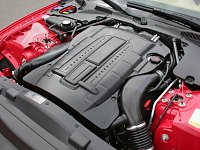 However,
the ugliest part of XKR is not the cabin, but the engine: the 4.2-liter
all-aluminum 32-valve supercharged V8 is completely hidden under a
black plastic cover, which must be the ugliest engine you have ever
seen. It may be good for noise insulation, but I am sure everybody will
prefer to see the real face of the mechanicals rather than a plastic
pseudo engine. Take note, Ian Callum. However,
the ugliest part of XKR is not the cabin, but the engine: the 4.2-liter
all-aluminum 32-valve supercharged V8 is completely hidden under a
black plastic cover, which must be the ugliest engine you have ever
seen. It may be good for noise insulation, but I am sure everybody will
prefer to see the real face of the mechanicals rather than a plastic
pseudo engine. Take note, Ian Callum.
The engine itself is close to the XK's
and even closer to the last XKR. An Eaton supercharger is added to
boost power to 420hp at 6250rpm (that's surprisingly more revvy than
the naturally aspirated version) and torque to 413 lbft at 4000 rpm. In
other words, only 20hp and 5 lbft more than the old car. Luckily, the
all-aluminum car is 70 kg lighter than before, so a couple of tenths is
slashed from 0-60. Yes, it is not as explosive as M6 and SL55 AMG, but
for a grand tourer the supercharged AJ-V8 engine is close to perfect:
smooth, responsive, torquey and good sound. The supercharger whine is
largely reduced, letting the nice exhaust noise to take the leading
role. The latter is more civilized than Aston's, so perfectly suitable
to Jaguar.
 The ZF
6-speed automatic programmed by Jaguar is currently the best automatic
in the world. In automatic mode it shifts seamlessly yet slightly
quicker than in the XK. The program detects your driving mood and
select the right gears. For example, if you are driving hard it will
hold the gear until higher rev or downshift earlier so that to enhance
acceleration. During a downshift it will blip up the engine to match
rev. In manual mode it responds instantly to driver input through the
steering wheel-mounted paddles. No other automatics could be so
satisfying to keen drivers. The ZF
6-speed automatic programmed by Jaguar is currently the best automatic
in the world. In automatic mode it shifts seamlessly yet slightly
quicker than in the XK. The program detects your driving mood and
select the right gears. For example, if you are driving hard it will
hold the gear until higher rev or downshift earlier so that to enhance
acceleration. During a downshift it will blip up the engine to match
rev. In manual mode it responds instantly to driver input through the
steering wheel-mounted paddles. No other automatics could be so
satisfying to keen drivers.
Although the aluminum chassis of XK coupe is already very rigid, Jaguar
still added a tower brace to reinforce its rear suspensions. The
springs in suspensions are stiffened by 38% up front and 26% at the
rear. The CATS adaptive damping is recalibrated to 25% firmer. The
anti-roll bars becomes thicker. The steering becomes quicker. The
brakes are also enlarged.
 On the
road, XKR won overwhelming praises from journalists all over the world.
Many German grand tourers work better on track than on public roads,
which is nonsense considering their drivers will never took them to
racing tracks. But XKR is vice versa. It is a real grand tourer
designed for real roads, no matter highway or back roads. Its handling
is excellent for a grand tourer. It has remarkable poise, neutrality
and grip. Its torquey engine and responsive gearbox adds to the feel of
integrity. But most impressive is how well it deals with rough surfaces
simultaneously. No German grand tourers know how to soak up bumps
better than Jaguar. It flows smoothly from bend to bend. The fluidity,
refinement and effortless performance are exactly what great GTs
required. On the
road, XKR won overwhelming praises from journalists all over the world.
Many German grand tourers work better on track than on public roads,
which is nonsense considering their drivers will never took them to
racing tracks. But XKR is vice versa. It is a real grand tourer
designed for real roads, no matter highway or back roads. Its handling
is excellent for a grand tourer. It has remarkable poise, neutrality
and grip. Its torquey engine and responsive gearbox adds to the feel of
integrity. But most impressive is how well it deals with rough surfaces
simultaneously. No German grand tourers know how to soak up bumps
better than Jaguar. It flows smoothly from bend to bend. The fluidity,
refinement and effortless performance are exactly what great GTs
required.
For handling and feedback, the big
Jaguar is still no match with the nimble Porsche 911, or to lesser
extent Aston V8 Vantage. But from grand tourer point of view, no one
else is more satisfying to drive. My only reservations are about its
design - which is so-so now and easily aging in the future - and the
cheap-looking cabin. Image-wise, Jaguar still has a thing or two to
learn from Mercedes SL. The latter also has a superior retractable roof
to justify the higher price.
However, there is no doubt that XKR has finally evolved from a lazy cat
to a jaguar.
|
Verdict:     |
Published
on 10
Jun 2009
|
All rights reserved.
|
|
XK and XKR 5.0
|
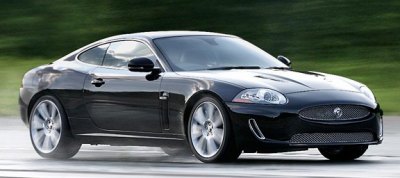
|
The XKR still combines speed, control
and refinement like no others...
|
Having
read our new XF 5.0 and XFR report, it won’t be difficult to understand
the new XK and XKR 5.0. Under the limelight is the Gen III Jaguar
AJ-V8, now enlarged to a full 5 liters and is equipped with goodies
like dual-continuous VVT and direct injection. In naturally aspirated
form, it also gets 2-stage variable intake valve lift and 2-stage
variable length intake manifolds. Output jumps to 385 hp and 390 lb-ft,
nearly matching the old supercharged engine. 0-60 mph is dramatically
reduced to 5.2 seconds.
The 5.0-liter supercharged XKR is even stronger – 510 horsepower
instead of the previous 420 hp, 461 lb-ft of torque against 413 lb-ft,
0-60 mph is reduced by 0.3 second to just 4.6 seconds. 0-100 mph dips
below the once-supercar-defining border of 10 seconds. Mid-range
acceleration is even more sensational, which sees 50-70 mph taking 1.9
seconds instead of 2.5 seconds. XKR is a 911 killer.
Apart from performance, the big cat also inches closer to the 911
territory in handling. A change in tuning philosophy means it has
sacrificed part of the previous supple ride and impeccable refinement
for a sportier character. The suspension springs are considerably
stiffer. The new continuous adaptive damping (which replaced the
2-stage CATS) and electronic active differential (standard on XKR)
sharpen its handling a lot, bringing tighter body control and keener
turn-in. Although the suspension could be caught out by poor surfaces
at times, its ride quality is still better than other German and
Italian
grand tourers on the market. The XKR combines speed, control and
refinement like no others.
Externally, the 5.0 cars are refreshed with a pair of vertical brake
intakes at either side of the front bumper. Certainly more elegant than
the original design. Inside, Jaguar has no budget to redo the ugly
dashboard, but it has applied upgraded materials and XF’s rotary gear
selector to brighten things up.
|
Verdict:     |
Published
on 3
Jun 2011
|
All rights reserved.
|
|
XKR-S
|
|
Were Jaguar and
Aston
Martin still owned by Ford, we would have never seen a car like this
XKR-S. Priced at £97,000 in Britain, it has entered the territory
of Aston Martin V8 Vantage. Not just that. Aston will find the super
big cat far more powerful, faster yet more effortless to drive than its
car. With the self-imposed boundary removed, now the only limit to
Jaguar will be the sky.
Frankly, the styling tweaks from XKR to XKR-S is not the best effort
from Ian Callum. Its aggressive mouth, side skirts and tail spoiler
lack the coherence found on the regular car. However, their
contribution to reduced aerodynamic lift is undoubted. Same go for the
larger diffuser sandwiched between the quad-exhaust. Cooling is
enhanced by two extra intakes opened just
above the oval grille. Inside, the most obvious upgrade is a pair of
Recaro bucket seats, which is a delight to keen drivers.
Under the bonnet sits the same 5-liter supercharged V8 as the XKR. Its
deep reserves are released by a new free-flowing exhaust and an ECU
tweak. Maximum power is pumped by 40 hp to 550 hp, matching the mighty
XJ220 as the most powerful road car ever built by Jaguar. Peak torque
increases by a similar amount to 501 pound-foot, and its wide torque
band remains. The XKR-S is claimed to sprint from standstill to 60 mph
in 4.2 seconds, 0.4 quicker than XKR. 0-100 mph takes a mind-blowing
8.6 seconds. Its speed regulator is raised to 186 mph, satisfying those
seeking a place in the 300 kph Club. However, with so much power, I
would say its potential could exceed 200 mph.
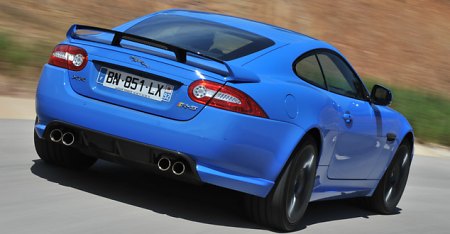 |
Modifications to the chassis are quite
subtle. The suspension is
lowered by 10 mm and fitted with 28 percent stiffer springs. The
adaptive
damping and active differential are reprogrammed in line with its
increased performance. The steering knuckles at the front suspension is
beefed up to tighten the steering. New alloy wheels are lighter, while
rear tires get slightly wider.
On the road, the XKR-S feels noticeably faster than the regular XKR,
which is already a fast car. The supercharged V8 produces tremendous
punch, especially in mid-range. Moreover, it stays longer than the
XKR's unit, offering a freer top end for driving addicts to enjoy. The
new exhaust plays a louder, harder edge soundtrack, although the
supercharger whine at the background prevents it from thrilling as much
as a Maserati V8 or Aston V12.
The higher performance is well matched with the chassis. XKR-S corners
with poise and grip that the regular XKR cannot hope for. Its steering
is more precise and feelsome. It's not a lightweight track car like
Porsche 911 GT3, but for a front-engined GT its handling on track is
remarkable – Jaguar said it has no problem to lap Nurburgring under 8
minutes. On the other hand, the suspension is still capable of soaking
up most bumps on the road, so it remains a true GT.
To more demanding drivers, this car is undoubtedly better than other
versions of XK. However, at this price it competes with some truly
great rivals, most notably Porsche GT3, Maserati MC Stradale and Audi
R8 V10. Compare with them, the Jaguar's look is undeniably a little
dull, its interior too ordinary, its engine noise a little boring and
its compulsory automatic transmission, while effortless to use
everyday, is never as engaging as a great manual. Despite of its new
found ability, it still lacks an emotional appeal to take on the best
rivals.
|
Verdict:     |
Published
on 24
Dec 2013
|
All rights reserved.
|
|
XKR-S GT
|
|

|
First, there was an XK
coupe. Then came the supercharged XKR and its even hotter version
XKR-S. Now finally the ultimate expression, XKR-S GT. It is going to be
rare, with only 30 left-hand-drive cars destined to the US and about
the same number of right-hand-drive cars available to its home market
(the exact number will depend on demand). It is going to be expensive,
costing £135,000. That's more than twice the price of the base
XK, or about the same as a Porsche 991 Turbo S, a Nismo GT-R or an
Aston Martin V12 Vantage S – all are highly regarded super-performance
cars. Isn't it mad to chase these rivals?
At first it looks yes. The XKR-S GT is deemed to be a road-and-track
car like Porsche 911 GT3 RS. It gets massive aerodynamic kits made of
carbon-fiber, like the high-mounted rear spoiler, extended front
splitter, air vanes and diffusers. They contribute to 145 kg of down
force at 186 mph, which is also the electronically regulated top speed
of the car. Its interior has the rear seat replaced with a roll cage.
Lightweight front buckets with four-point harnesses and reduced sound
insulation cut further weight. Brembo carbon ceramic brakes (398mm
front and 380 mm rear) save another valuable 21 kg of unsprung weight.
Despite that, the big cat still weighs some 1713 kg (40 kg down from
XKR-S). After all, this is a large luxury grand tourer in essence. To
see it as a rival to the compact and lightweight GT3 (RS or not) is
probably unrealistic. Jaguar said it lapped Nurburgring in 7 min 40
sec, which is fine until you realize the GT3 did that in 7 min 25 sec!
It goes without saying Nismo GT-R is faster still.
The 5-liter supercharged V8 is carried over from the XKR-S. Some might
feel disappointing for the lack of upgrade, but I suppose its 550
horsepower output and especially the thick torque band (501 lbft from
2500 to 5500 rpm) is already right on the limit of the rear-wheel-drive
chassis. 0-60 mph in 3.9 seconds still causes a lot of sensation.
Moreover, its new variable exhaust produces an angrier noise, which is
further amplified by the thinly insulated cabin. It barks crazily on
prod of throttle and explodes on overrun like a true race car. The
aural experience is just as thrilling as any hardcore rivals.
If there is any disappointment, it should be the old 6-speed automatic.
Its upshift is slower and mushier than the latest ZF 8-speed auto, let
alone the twin-clutch gearboxes that its main rivals use. On public
roads this isn't to be too noticeable, but for a track car this is hard
to forgive.
Instead of powertrain, Jaguar spent most effort to improve the chassis.
The quick-ratio steering rack accompanied with (still hydraulic) power
assistance is
taken straight from the new F-type. Most of the
front and rear suspension components also come from the F-type,
including the control arms, uprights, bushings, bearings and rear
subframe. This widens its
front track by 52 mm and increases camber. Spring rates have been
increased by a massive 68 percent up front
and 25 percent at the rear, with re-calibrated adaptive dampers to
match. The relatively stiffer front axle should improve turn-in
response and shift the cornering attitude from understeer to neutral,
while the relatively softer rear axle should benefit traction. Traction
and grip are enhanced further by adopting semi-slick Pirelli P-Zero
Corsa rubbers.
The rear tires are now wider at 305/30ZR20.
On track, the GT has its handling transformed. The ceramic brakes are
finally a match to the strong performance. Body control is much tighter
than the XKR-S. Moreover, it shows a new-found balance and precision.
It steers into corners much more accurately, with little hesitation and
over-reaction, just point to direction you command. On dry surfaces,
the Corsa tires grip hard and put down the power cleanly, keeping the
tail pinned on track. You can induce oversteer with throttle and
steering, of course, but at no times it will breakaway suddenly like
the shorter wheelbase F-type V8 S. On wet or damp surfaces, however,
the semi-slick rear tires struggle to contain the huge torque and its
handling becomes edgy, so you need to drive with self-restraint to
avoid going sideway. On inherent balance and agility, the Jaguar is not
as good as Aston V12 Vantage S.
Nevertheless, it is undoubtedly the more comfortable car to drive on
normal roads. This is not only down to the self-shifting gearbox but
also a calmer steering and a surprisingly supple ride, which is almost
as good as the XKR-S. Despite of the track-focused modifications, the
GT has lost little of the Jaguar DNAs.
Return to our question, is it good enough to be so expensive? Well, the
ultimate XK has its own charisma, but a V12 Vantage S feels sharper, a
Nismo GT-R far faster and a 911 Turbo S more versatile. Above all, a
911 GT3 is more pleasurable to drive on both road and track yet costing
a third less. That is why the Jaguar is to be built in much smaller
quantity. However, it does demonstrate that Jaguar is finally capable
to build a world-class chassis. In the future we should see even better
things coming out of Gaydon.
|
Verdict:     |
|
|
|
|
|
|
|
|
|
|
XK
4.2
|
2006
|
| Front-engined,
RWD |
| Aluminum monocoque |
| Aluminum |
| 4791 / 1892 / 1322 mm |
| 2752 mm |
V8, 90-degree
|
| 4196 cc |
DOHC 32 valves, VVT
|
| - |
| - |
| 300 hp |
| 310 lbft |
6-speed automatic
|
F: double-wishbones
R: wishbone + upper link
|
| Adaptive damping |
F: 245/40ZR19
R: 275/35ZR19
|
1595 kg
|
| 155 mph (limited) |
5.9 (c) / 6.0* / 5.7**
|
15.0* / 13.9**
|
|
XKR
4.2
|
2006
|
| Front-engined,
RWD |
| Aluminum monocoque |
| Aluminum |
| 4791 / 1892 / 1322 mm |
| 2752 mm |
V8, 90-degree
|
| 4196 cc |
DOHC 32 valves, VVT
|
| Supercharger |
| - |
| 420 hp |
| 413 lbft |
6-speed automatic
|
F: double-wishbones
R: wishbone + upper link
|
| Adaptive damping |
F: 255/35ZR20
R: 285/30ZR20
|
1665 kg
|
| 155 mph (limited) |
4.9 (c) / 4.2** / 4.5***
|
10.1** / 10.9***
|
|
XK 5.0
|
2009
|
| Front-engined,
RWD |
| Aluminum monocoque |
| Aluminum |
| 4794 / 1892 / 1322 mm |
| 2752 mm |
V8, 90-degree
|
| 5000 cc |
DOHC 32 valves, DVVT, VVL
|
| VIM |
| DI |
385 hp / 6500 rpm
|
390 lbft / 3500 rpm
|
6-speed automatic
|
F: double-wishbones
R: wishbone + upper link
|
| Adaptive damping |
F: 245/40ZR19
R: 275/35ZR19
|
1660 kg
|
| 155 mph (limited) |
5.2 (c) / 5.0*** / 4.7****
|
11.6***
|
|
|
|
|
|
Performance
tested by: *Autocar, **R&T, ***C&D, ****Auto Bild
|
|
|
|
|
|
|
XKR 5.0
|
2009
|
| Front-engined,
RWD |
| Aluminum monocoque |
| Aluminum |
| 4794 / 1892 / 1322 mm |
| 2752 mm |
V8, 90-degree
|
| 5000 cc |
DOHC 32 valves, DVVT
|
| Supercharger |
| DI |
510 hp / 6500 rpm
|
461 lbft / 2500-5500 rpm
|
6-speed automatic
|
F: double-wishbones
R: wishbone + upper link
|
| Adaptive damping |
F: 255/35ZR20
R: 285/30ZR20
|
1753 kg
|
| 155 mph (limited) |
4.6 (c) / 4.0*
|
8.8*
|
|
XKR-S
|
2011
|
| Front-engined,
RWD |
| Aluminum monocoque |
| Aluminum |
| 4794 / 1892 / 1312 mm |
| 2752 mm |
V8, 90-degree
|
| 5000 cc |
DOHC 32 valves, DVVT
|
| Supercharger |
| DI |
550 hp / 6500 rpm
|
501 lbft / 2500-5500 rpm
|
6-speed automatic
|
F: double-wishbones
R: wishbone + upper link
|
| Adaptive damping |
F: 255/35ZR20
R: 295/30ZR20
|
1753 kg
|
| 186 mph (limited) |
4.2 (c) / 4.2** / 4.1***
|
8.6 (c) / 8.6** / 9.2***
|
|
XKR-S GT
|
2013
|
| Front-engined,
RWD |
| Aluminum monocoque |
| Aluminum |
| 4794 / 1892 / 1312 mm |
| 2752 mm |
V8, 90-degree
|
| 5000 cc |
DOHC 32 valves, DVVT
|
| Supercharger |
| DI |
550 hp / 6500 rpm
|
501 lbft / 2500-5500 rpm
|
6-speed automatic
|
F: double-wishbones
R: wishbone + upper link
|
| Adaptive damping |
F: 255/35ZR20
R: 305/30ZR20
|
1713 kg
|
| 186 mph (limited) |
3.9 (c)
|
-
|
|
|
|
|
|
Performance tested by: *C&D,
**R&T, ***Sport Auto
|
|
|
|
|
|
|
|
|
Copyright©
1997-2013
by Mark Wan @ AutoZine
|
|